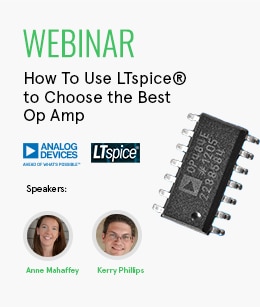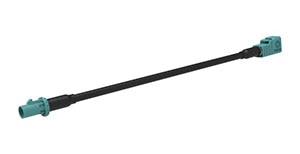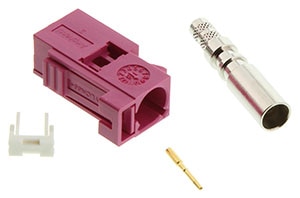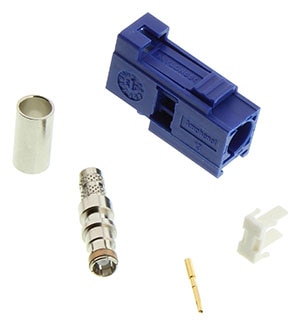What is a FAKRA connector?
The FAKRA (acronym for "Fachkreis Automobil") standard describes an RF connector that is widely used in the automobile industry. The German name translates into English as "Working Group Automobile." It defines the mechanical and electrical characteristics of a connector's interface. FAKRA connects coaxial cables to GPS, satellite radio, cellular communications, and FM signals. The connector consists of a plug and jack that mate via a push-on mechanism. Figure 1 depicts the FAKRA connector.

Figure 1: FAKRA Connector
FAKRA connectors are reliable, easily installed, and can handle RF signals for effective vehicle communication and entertainment.
Are there different types of FAKRA connectors?
FAKRA connectors vary and are categorized by mounting type, contact type, gender type, and application. They are also distinguished by their color-coded plastic housings, which adhere to the FAKRA coding industry standard (explained below). The individual types will be discussed later in this guide.
What are the different configurations of FAKRA connectors?
FAKRA connectors are available in various configurations for different automotive applications. As shown in Figure 2/3/4, they come in straight and right-angle solutions, edge-launch, and PCB designs. They are available in various shapes and sizes to accommodate different mounting positions and orientations inside a vehicle.

Figure 2: FAKRA Straight Jack to Straight Jack Cable Assembly

Figure 3: FAKRA Right Angle Connector

Figure 4: FAKRA Right Angle Crimp Jack
| Gender | Jack, Plug |
|---|---|
| Termination Style | Cable - Crimp PCB - Surface Mount PCB - Through Hole |
| Orientation | Right Angle and Straight |
| FAKRA Keycode | 14 combinations (A, B, C, D, E, F, G, H, I, K, L, M, N, Z) |
Table 1: Different combinations of FAKRA connectors
Figures 5 and 6 illustrate the cable mount construction for unsealed and sealed FAKRA connectors.

Figure 5: Cable mount construction for Unsealed FAKRA connectors

Figure 6: Cable mount construction for Sealed FAKRA connectors
FAKRA connectors are color-coded and optimized for specific applications. The color-coding makes it easy to identify and connect components without confusion. Additionally, FAKRA connectors have mechanical keying mechanisms to prevent mismating and allow flexibility in designing and configuring automotive systems.
Shop for more FAKRA Connectors, Cable Assemblies, and Accessories from Amphenol RF
What are the different generations of FAKRA Connectors?
There have been different iterations of FAKRA connectors. Table 2 shows the differences between the four generations. Generation 1.0 connectors are designed for easy identification and assembly, with a modified metal Sub-Miniature version B (SMB) connector embedded in a plastic housing unit. They meet automotive industry standards and can perform up to 4 GHz. Generation 1.0 connectors feature a die-cast or machined body with machined contact. Generation 2.0 connectors offer reduced installation costs through pre-assembled housing units. Generation 2.5 connectors also feature pre-assembled housing units as well as improvements in design, but require automated tooling for assembly.
| Design Features | Tooling | Production | Compliance | Packaging | |
|---|---|---|---|---|---|
| GEN 1.0 | Machined Body, Machined Contact, Unassembled Housing | Hand Tooling | Low Volume | USCAR-17 USCAR-18 DIN 72594-1 |
Tray Pack Bulk Components |
| GEN 2.0 | Die-cast body, Singulated Stamped or Machined Contact, Pre-Assembled Housing | Hand Tooling | Low Volume | USCAR-17 USCAR-18 DIN 72594-1 |
Tray Pack USCAR-18 DIN 72594-1 |
| GEN 2.5 | Die Cast Body, Stamped Contact, Pre-Assembled Housing | Automated Tooling Semi-Automated Tooling | High Volume | USCAR-17 USCAR-18 DIN 72594-1 |
Tray Pack Contacts are sold separately on tape and reel |
| GEN 3.0 | Die Cast Body, Stamped Contact, Pre-Assembled Housing | Automated Tooling Semi-Automated Tooling | High Volume | USCAR-17 USCAR-18 DIN 72594-1 |
Tray Pack Contacts are sold separately on tape and reel |
| GEN 4.0 | Stamped Body, Stamped Contact, Stamped Sleeve, Unassembled Housing | Fully Automated Tooling | High Volume | USCAR-17 USCAR-18 DIN 72594-1 6Q0.90.961D 6Q0.90.961E |
Tray Pack for Housing Other components are sold on tape and reel. |
Table 2: Differences between the FAKRA generations
Generation 3.0 jacks have a closed-entry interface and a protected outer contact for greater durability. Generation 4.0 connectors are designed for high-volume, high-speed automated cable assembly production. The connector housings are removable, allowing field replacement if necessary.
Amphenol RF's FAKRA connectors, ranging from Gen 1.0 to 3.0, are suitable for traditional connected car systems, including LVDS surround camera systems, infotainment, GPS, and satellite radio. Gen 4.0 connectors, made especially for autonomous vehicles, are fitted in V2X applications such as blind spot monitoring, emergency vehicle warning systems, and autonomous braking.
What is the FAKRA standard?
The FAKRA connector standard is a global standard for automotive connectors. The standard specifies a plastic housing and 14 mechanical, color-coded elements to prevent incorrect mating. The standard is globally accepted by major car manufacturers and system suppliers for automotive communications and entertainment applications. FAKRA is standardized under USCAR and ISO 20860 standards. The FAKRA standard specifications are:
| Impedance | 50 Ohm |
|---|---|
| Frequency Range | DC - 6 GHz |
| Voltage Rating | 335 Volts RMS Continuous |
| Dielectric Withstanding Voltage | 800 VRMS Max |
| VSWR (Return Loss) (3 - 6 GHz) | 1.6 (-13dB) Max |
| Insulation Resistance | 100 MΩ Min |
| Insertion Loss (3 - 6 GHz) | 0.45 dB |
| Power Handling | 95 W Max @ 1 GHz @ 25ºC |
| Mating Cycles | 100 Min |
| Coupling Mechanism | Push-On |
| Temperature Range | −40°C to +105°C |
Table 3: FAKRA Connectors Specifications
The FAKRA standard enables compatibility and interchangeability across manufacturers and vehicle models, simplifying the supply chain and reducing procurement complexities. FAKRA connectors are engineered for reliable performance in automotive environments, where they can be subjected to vibration, temperature fluctuations, and environmental factors. The robust design and materials contribute to their durability and long-term functionality.
What is the FAKRA color coding system?
FAKRA connectors use color-coding to identify different functions within a vehicle's RF and communication systems. The color-coding simplifies installation and maintenance by ensuring that specific connectors are used for their respective applications. The FAKRA color code system is standardized across multiple manufacturers. Figure 7 shows the standard color code associated with each application.

Figure 7: FAKRA color coding (Source: Amphenol RF)
What are some of the applications that FAKRA connectors are used for?
FAKRA connectors are standard interfaces for high frequency telematic applications in the automotive sector. Applications include GPS, antennas, satellite radio, cameras, ECU/compute modules, tire pressure monitoring, infotainment systems, and remote entry/start.
FAKRA connectors carry signals from external GPS antennas to internal vehicle systems, providing navigation assistance and enabling first responders to locate vehicles in emergencies. FAKRA connectors are used to transmit low-voltage differential signals (LVDS) in next-generation digital cameras for external surround and interior cabin monitoring vehicle systems. In addition, they support Dedicated Short Range Communication technology (DSRC), allowing high data transmission in active safety applications.
Frequently Asked Questions (FAQs)
In partnership with
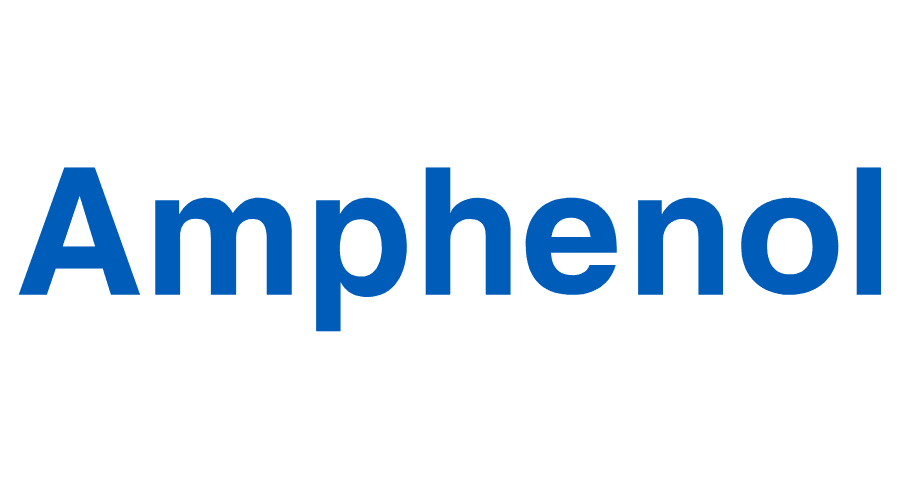
What is the difference between FAKRA and HSD connectors?
Although both find use in automotive applications, FAKRA and HSD connectors differ in design, specifications, and features. Figure 8 depicts both types of connectors.

Figure 8: FAKRA and HSD connector
Application:
FAKRA: FAKRA connectors are primarily used in the automotive industry for connecting various components such as radios, GPS receivers, and antennas. They are designed to carry both power and signal connections.
HSD: HSD connectors are also used in the automotive industry, but they are specifically designed for high-speed data transmission, such as for Ethernet or LVDS (Low-Voltage Differential Signaling) connections.
Design:
FAKRA: FAKRA connectors typically have a plastic housing and use a standard SMB (Sub-miniature version B) or SMB-like interface. They are color-coded for different applications to prevent incorrect connections.
HSD: HSD connectors are designed for high-speed data, so they have a more robust construction to minimize interference and maintain signal integrity. They often use shielded twisted-pair cabling for noise reduction.
Frequency and Data Rate:
FAKRA: FAKRA connectors are generally used for lower-frequency applications, such as FM/AM radio or GPS signals. They are not designed for high-speed data transmission.
HSD: HSD connectors are designed to handle high-frequency signals and are capable of supporting high-speed data transmission, often in the GHz range, suitable for modern automotive applications like Ethernet networking.
Signal Type:
FAKRA: FAKRA connectors are used for both power and analog signals, making them versatile for various automotive applications.
HSD: HSD connectors are specifically designed for digital data signals and are optimized for minimizing signal degradation over long cable lengths.
Interchangeability:
FAKRA: FAKRA connectors are generally not interchangeable with other connector types due to their specific design and color-coding for different functions.
HSD: HSD connectors are designed to meet certain industry standards, which can make them more interchangeable between different manufacturers' products if they adhere to the same standards.
What is the frequency range of the FAKRA connector?
FAKRA connectors are designed to perform from DC to 6.0 GHz.
What is the maximum length of the FAKRA cable?
The maximum length of a FAKRA cable can vary depending on several factors, including the specific FAKRA connector type, the cable's construction, and the signal frequency being transmitted. FAKRA connectors are commonly used in automotive applications, such as for connecting antennas or other devices, and the maximum cable length can vary for different applications.
In general, FAKRA cables are intended for relatively short cable runs within a vehicle, typically ranging from a few inches to a few meters. They are not designed for long-distance signal transmission like some other types of connectors and cables.
To determine the maximum length of a FAKRA cable for your specific application, you should consider factors such as signal frequency, signal integrity requirements, and any industry or manufacturer guidelines. Using signal boosters, repeaters, or signal conditioning equipment may also extend the effective range of FAKRA cables in some cases, but this depends on the specific signal and application requirements.
Can a FAKRA Connector be mounted on a PCB?
FAKRA connectors can be mounted on PCBs. FAKRA connectors are designed for PCB applications in RF and microwave systems, featuring a thru hole connector mount interface.
Is FAKRA the same as an SMB connector?
FAKRA connectors are based on SMB, but have an additional plastic housing that contains a mechanical locking device designed to prevent disconnection in high-vibration applications.
What is the impedance of FAKRA connectors?
FAKRA connectors are designed with a characteristic impedance of 50 Ω nominal.
What communication protocols are supported by FAKRA?
FAKRA connectors themselves are primarily mechanical connectors designed for use in automotive applications, and they are not communication protocols. Instead, they are used to physically connect and secure cables that transmit various types of signals, including analog and digital signals. The choice of communication protocol depends on the specific devices connected using FAKRA connectors and the intended purpose within the vehicle.
Common communication protocols that may be transmitted over cables connected with FAKRA connectors in automotive applications include:
Analog Radio Signals: FAKRA connectors are often used for connecting antennas to car radios, which typically receive analog AM/FM radio signals.
Digital Radio Protocols: In modern vehicles, digital radio protocols like DAB (Digital Audio Broadcasting) or HD Radio may also be transmitted over cables connected via FAKRA connectors.
GPS: FAKRA connectors can be used for GPS antennas, which communicate using satellite navigation protocols like GPS, GLONASS, or Galileo.
Ethernet: In more advanced automotive systems, FAKRA connectors may be used for Ethernet connections, supporting communication protocols such as Ethernet AVB (Audio Video Bridging) for multimedia and data sharing within the vehicle.
LVDS (Low-Voltage Differential Signaling): FAKRA connectors can transmit LVDS signals, which are commonly used for high-speed data communication in displays and cameras within the vehicle, such as in infotainment systems or rearview cameras.
CAN Bus (Controller Area Network): FAKRA connectors may be used for connecting components in a CAN Bus network, a common automotive communication protocol for various control systems within the vehicle.
FlexRay: In some automotive applications, FAKRA connectors may be used for FlexRay communication, a real-time communication protocol used for advanced control systems.
The specific communication protocol supported by a FAKRA connector and cable assembly depends on the devices being connected and the intended use case within the vehicle. FAKRA connectors are designed to handle a wide range of signals, and the choice of protocol will depend on the automotive system's requirements and the signals it needs to transmit or receive.

